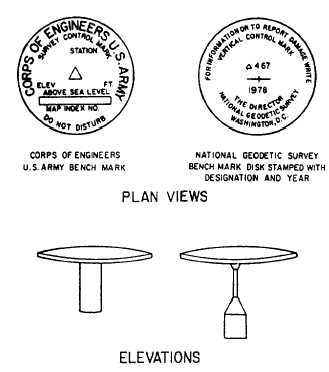generally marked with permanent markers. These
markers could be in the following forms:
. A bronze disk set in concrete
l An iron pipe filled with concrete
. A crosscut on an existing concrete structure
or on a rock outcrop
. A hole drilled in concrete and filled with
lead or a metal rod driven into the ground with
a center-punched mark to designate the exact
point
All permanent survey station markers should
be referenced so they can be replaced if disturbed.
Methods of referencing points are discussed later
in this training manual.
Surveyor’s tacks, spikes, and nails are often
driven into growing trees, bituminous, or other
semisolid surfaces as permanent markers. A nail
will be more conspicuous if it is driven through
a bottle cap, a washer, a plastic tape, or a
“shiner.” A shiner is a thin metal disk much like
the top or bottom of a frozen fruit juice can.
A SPAD is a nail equipped with a hook for
suspending a plumb bob. It is driven into an
overhead surface, such as the top of a tunnel. The
plumb bob will locate on the floor the point
vertically below the point where the spad is driven.
Points on concrete or stone surfaces are often
marked with an X cut with a hammer and chisel.
Another way to do this is to cut holes with a star
drill and then plug them with lead.
A much more durable form of marker is made
of a length of metal pipe—usually called iron pipe
regardless of the actual metal used. Lengths run
from about 18 to 24 in. Sawed-off lengths of pipe
have open ends; pipes cut with a shear have
pinched ends and are called pinch pipe. There are
also manufactured pipe markers, some of which
are T-shaped rather than cylindrical in cross
section. A commercial marker may consist of a
copper-plated steel rod. All commercial markers
have caps or heads that permit center punching
for precise point location and stamping of the
identifying information.
A still more durable form of marker is the
concrete monument. A short length of brass rod
is often set in the concrete to mark the exact
location of the point. Concrete monuments that
are used as permanent markers by various federal
survey agencies have identifying disks set in
concrete, like those shown in figure 11-57.
Figure 11-57.-Various types of federal marking disks.
Points on concrete or masonry surfaces may
be permanently marked by setting lengths of
cylindrical brass stock into holes plugged with lead
or grout. Brass stock markers set in pavement are
commonly called coppers. Manufactured brass
disks, similar to the ones shown in figure 11-57,
may be set in grouted holes in street pavements,
sidewalks, steps, or the tops of retaining walls.
Points on bituminous surfaces maybe marked by
driving in pipe, railroad spikes, or case-hardened
masonry nails, commonly called PK nails. A
center punch for marking a precise location on
metal stock or metal caps is a common item of
equipment for a surveyor.
MARKING MATERIALS
KEEL, or LUMBER CRAYON, is a thick
crayon used for marking stakes or other surfaces.
Common marking devices that contain a quick-
drying fluid and a felt tip are also popular for
marking stakes. All of these types of graphic
marking materials come in various colors.
In addition to keel, paint is used to mark
pavement surfaces. Paint may be brushed on or
sprayed from a spray can. To make the location
of a point conspicuous, use a circle, a cross, or
a triangle. Identification symbols, such as station
11-48

